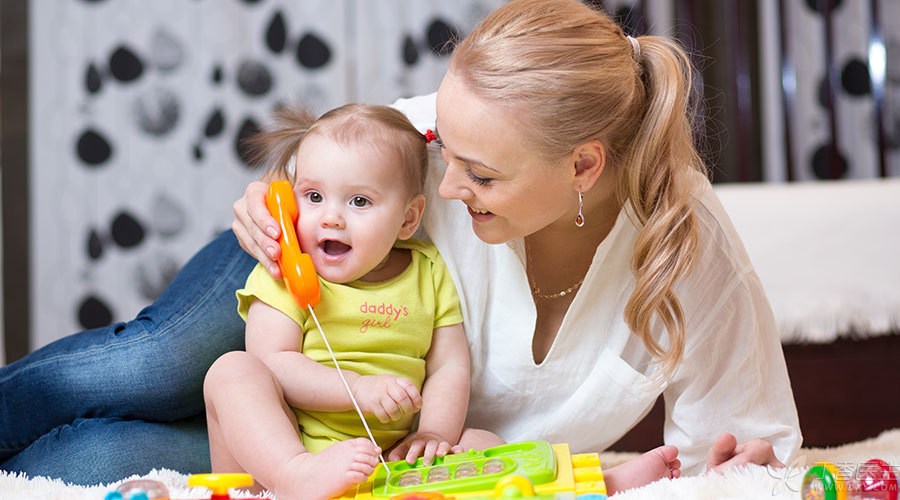
Language development is a favorable tool for baby’s thinking development. 0 ~ 3 years old is an important period for baby’s language development. During this period, adequate language input and appropriate guidance can lay a good foundation for baby’s future language expression ability development.
But during this period, there are always some baby’s performance that worries mothers.
My daughter always talks to herself and babbles. The family does not know that she said what. When I went to early childhood education, other children interacted with the teacher. My baby what understood it and refused to say it.
Mingming reads stories every day, Mingming sees what teaching the baby to learn to say, Mingming’s family is playing story machines from morning till night, why is the baby [golden mouth is hard to open]?
In addition to physiological factors and individual differences, the greatest possibility that the baby [golden mouth is difficult to open] is that we touched the following five minefields while teaching the baby to speak.
Have you been recruited in these five minefields?
Minefield 1: When the baby gestures to you with simple gestures, you immediately get the message and do it as soon as possible.
The mother’s [heart-to-heart] proves the hot pillow feedback on the baby’s needs, which is of course necessary. However, if you always understand the baby’s body movements quickly and meet the baby’s needs immediately, the baby may not be too lazy to express the needs with words.
Correct Approach: When the baby gestures another word he can already say, Pretend not to understand and try to guide your baby to say what he needs. This will give the baby a chance to gradually learn to express his needs in words. For example, when the baby reaches for an apple on the table, he can ask him an alternate question: “Do you want what, an apple or a cup (the cup is next to the apple)? ]
Here, pay attention to the appropriate way to guide the baby to use language, and avoid overcorrection, ordering or forcing the baby to use language, such as: [I don’t understand what you mean by what, you say it and say “I want apples”]. If you must insist on letting the baby speak out before you are willing to help him, the baby may feel [if I can’t say it, my mother won’t love me].
[Love is conditional], which is definitely not a good thing for the development of the baby.
Minefield 2: When the baby opens his mouth to imitate your speech, he always corrects the baby’s pronunciation immediately.
Pronunciation is not clear to clear, inaccurate to accurate, is a baby [learn to speak] must go through the process. However, if you always get the opportunity to correct your pronunciation, for fear of the child [saying the wrong thing], that is a bit too much. If you have been doing this all the time, please calm down and think about it: Are you too anxious about getting your baby [pronouncing correctly]?
In fact, in the initial stage of language development, [he wants to say] is the primary goal, while [speaking well] is the advanced goal.
Correct approach: No matter how the baby’s pronunciation is, give the response and encouragement in the first place. For example, if the baby says: [screen dog], you can say [apple, you want apple, that’s very good.] Let the baby be interested in opening his mouth, and he will be more active in opening his mouth. In addition, don’t repeat the wrong pronunciation of the baby because it is fun.

Minefield 3: The way the mother and the baby speak does not match the baby’s understanding level.
Some mothers learn that it is not good to say childish reduplicate words to their babies, so they try their best to talk to their babies in the way of adult dialogue. Even more excessively, they deliberately use many written terms like reading difficult and obscure monographs.
Unfortunately, doing so at the age of 0 ~ 3 does not make the baby better at expressing himself. For the baby, there is no action, expression, tone auxiliary long sentence, the amount of information is too large, difficult to understand. You think, if the baby understands it is difficult, then the input of information is invalid, let alone imitation and learning.
Correct approach: When the baby is just able to speak, try to slow down the speed of communication with the baby, use short sentences, and use body language or food, pictures to help the baby establish the connection between pronunciation and semantics. This communication process is more in line with the baby’s understanding level, so that the baby can communicate with you [happily].

Minefield 4: Lack of patience and easy temper make the baby afraid to chat with you.
For example, when you have taught your baby many times [help pass a pair of chopsticks], the baby still can’t understand it, so he is angry with the baby: [baby, mother didn’t teach you yesterday, chopsticks, here! ] For the baby, what you need most at the moment is your patience.
Now most mothers have paid great attention to the concept of “positive education”, Basically will not hurt the baby’s self-esteem. However, the mood in the pronunciation and intonation will also make the baby afraid of communicating with you, and will also produce inferiority complex when serious. This is not only not conducive to the development of the baby’s language, but also very harmful to the development of the baby’s emotional management ability.
Correct approach: Even if you are worried, you cannot bring your emotions to your child. In the above situation, you can take your baby over and say to the baby, “Baby, these are chopsticks. Mom put them here. Can you bring them to Mom next time?” ]
Minefield 5: Frequently Ask Questions to Test Baby Will
My dress is in what color? [What is this? [This little animal is called what? [Find out where the polar bear is? [These exam-like questions should not be used too much. I saw a 2-year-old mother interacting with her baby and pointing to the cardboard while bridging the bridge and asking him, “This is what? The baby looked and left. I asked my mother, has he touched the carton before? The mother thought for a moment and said: [It seems that there is no…] The mother is just used to this way of communication. However, in the baby’s view, the mother already knows the answer and deliberately asks him. It is a very strange thing. Frequent use is easy for the child to resist.
Correct Approach: Between the ages of 0 and 3, try to provide your child with as much information as possible in a natural way, such as: [There are many cartons and cardboard here.] Or when the child looks at your clothes, he can say: [My clothes are blue and there is a polar bear on them]. At this time, the child may touch the polar bear, and the mother can also touch it and then say: [Polar bear is fluffy.]
If you must want to test your child’s degree, you can use euphemistic and natural methods, such as asking him when playing with building blocks with your child: “I need 2 blue ones, can you help me get one?” ], instead of lifting a blue building block, ask [Is this what color? ]

[Three Ways to Clear] It is no longer difficult for the baby to open his mouth.
In addition to avoiding touching the five minefields on the upper surface, we can also use the following three tricks when teaching the baby to speak, so that the baby’s language can develop by going up one flight of stairs.
Tip 1: Communicate on the same channel and keep interested in talking.
The dialogue with the baby is on the same channel, which is the topic related to the current situation with the baby, which is the premise of maintaining parent-child interaction.
For example, a mother once asked me for help. She said that her baby could not remember the names of daily fruits and vegetables.
I suggest that she take her baby to the supermarket more often, where there are many varieties of vegetables and fruits, and they are very concentrated. More importantly, the baby reaches out and touches the real thing. Besides listening to the mother, the touch and smell will also deepen the memory of the language.
Sure enough, after going to the supermarket several times, her baby basically remembered the names of most vegetables and fruits.

Tip 2: Understand the baby’s language pattern and create opportunities for the baby to speak.
When the baby can express his wishes with [Yi, ah, ha, wu] and other sounds, it is a good time to train the baby to imitate pronunciation.
When they express that they need to be hugged, drink milk or want to take something, their mother takes the opportunity to express these wishes in simple words for them.
Repeat every day, the baby will strengthen these languages in their minds, and the baby’s pronunciation will gradually become clear from vague.
Tip 3: Talk about the names, features and functions of common items naturally.
All the things that you often encounter in your life can be your baby’s toys, Including bath balls, soap, spoons, shovels, faucets, washing machines, microwave ovens, etc. For example, if the child stares at the bath ball during the bath, It can be said that: [This is a bath ball (item name), You can touch it], Then tell the baby’s sensory experience: [Bath balls are very light, rough to the touch, and a little prickly.] Finally, if the baby’s understanding ability and attention are no problem at the age of 2-3, and he is still interested in bath balls, he can further talk about the function of bath balls: [Bath balls are used to make bubbles. Look, I squeeze the bath liquid into them, rub them again, rub them, and many bubbles will appear! ] Combined with the name, characteristics (color, size, length, hardness, weight, material, etc.), function three aspects, not afraid not to have to talk.
In short, create a dialogue situation with the baby and stimulate his desire to speak. The method should be grasped step by step, the content should be from simple to complex, and the sentence should be from short to long.
When you successfully avoid those minefields and use these three moves [bonus], it will be easier for the baby to open the [golden mouth] voluntarily.
